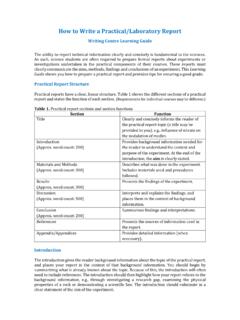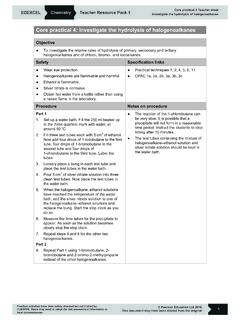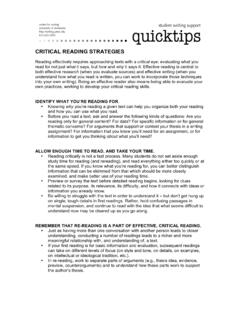Transcription of Core practical 3: Observe mitosis in root tips - Edexcel
1 Edexcel Biology B Teacher Resource Pack 1 Pearson Education Ltd 2015 This document may have been altered from the original 1 Core practical 3 Teacher sheet Observe mitosis in root tips practical activities have been safety checked but not trialled by CLEAPSS. Users may need to adapt the risk assessment information to local circumstances. Core practical 3: Observe mitosis in root tips Objectives Know how to prepare a temporary slide of a root tip to Observe mitosis Recognise the stages of mitosis in dividing cells Identify hazards, associated risks and control measures for the procedure Safety Specification links Eye protection must be worn.
2 Take care with glassware and scissors. Acetic orcein stain is corrosive, causes burns, has an irritating vapour and will stain. Wear eye protection and avoid contact with skin. If contact does occur, wash the area thoroughly with water for 10 minutes. Mop up spillages immediately. practical techniques 3, 4, 5, 8, 10 CPAC 1a, 2a, 2b, 3a 3c, 4a, 4b Procedure To see mitosis in action you need to look at living cells. Garlic bulbs grow roots that have actively dividing cells in their tips , in a region called the meristem. Each cell has only eight chromosomes so it is relatively easy to see the chromosomes once they have condensed.
3 In order to see the chromosomes inside the cells, the cells must be separated and spread out into a layer that is ideally just one cell thick. Plant cells are glued together by a middle lamella of pectins. Hydrochloric acid will break down the pectins that hold the cell together. Acetic orcein will stain the chromosomes dark red and fix the cells, stopping mitosis . You should examine your preparation carefully for cells undergoing different stages of mitosis . Identify the different stages by comparing your preparation with labelled pictures or photographs of cells during mitosis .
4 Bear in mind that mitosis is a dynamic process so cells may have been fixed in transition from one stage to the next you will have to interpret what you see. Make sure that all safety precautions given on this sheet are followed carefully. You should also have completed your own risk assessment prior to this practical . 1. This first step may have been done for you. Fill a small bottle with 1 mol dm 3 hydrochloric acid, and place it in a thermostatically controlled water bath set at 55 C. Leave the bottle for 15 minutes to let the acid warm to the temperature of the water bath.
5 2. Place a garlic clove in the top of the bottle so that the roots are submerged in the hydrochloric acid at 55 C. Leave the roots in the acid for 5 minutes. 3. After 5 minutes, take the clove out and rinse the roots thoroughly in tap water. Use a pair of sharp scissors to cut off several root tips of 5 10 mm in length. Let them fall into a small vial of acetic orcein standing on a white tile. Use the scissors to make sure that the root tips are immersed in the stain. Place a lid or laboratory stretch film onto the vial. Lids should have a pin-prick hole, or should be slightly loose if they are screw caps, to prevent the ejection of liquid when heating.
6 4. Place the vial containing root tips in acetic orcein in the 55 C water bath for 5 minutes to intensify the staining. 5. After 5 minutes, use forceps to take the tips out of the vial, and place them on a microscope slide. Add a drop of water to the root tip on the slide. Tease the root tip apart with needles (maceration), to spread out the cells a little. Cover with a coverslip. Replace the lid on the vial of stain and return it to the teacher as instructed. 6. Wrap the slide in several layers of paper towel and press gently on the paper to squash the tissues.
7 Take care not to twist the slide as you press down or the coverslip will break. Edexcel Biology B Teacher Resource Pack 1 Pearson Education Ltd 2015 This document may have been altered from the original 2 Core practical 3 Teacher sheet Observe mitosis in root tips practical activities have been safety checked but not trialled by CLEAPSS. Users may need to adapt the risk assessment information to local circumstances. 7. Examine under the microscope on low power to identify the area of dividing cells or meristem (see fig A in the Student sheet).
8 Position the cells in the centre of the field of view. Meristem cells are small and square, have no obvious vacuoles and are usually found in rows. 8. Move to high power ( 400). Identify as many stages of the cell cycle as you can in your field of view. 9. Count the number of cells in each of the stages of mitosis , plus interphase, in the field of view. Record your results in a table. 10. Draw and annotate one cell from each of the stages you have identified. Your drawings will be simple outlines of the cells and the groups of chromosomes in them; few other structures will be visible.
9 Aim to show the relative sizes and positions of the chromosomes and the cell accurately. Annotate your drawings to describe what is happening. Notes on procedure This practical should be used as an opportunity to develop risk assessment skills. Students will need guidance on how to do this. They should identify hazards and consider these, along with the likelihood of problems, to assess risk. They should suggest suitable control measures to reduce risk. Often a table is the best way to present this. Ideally, students should be provided with a brief outline of the practical and information about reagents prior to the activity and asked to produce their own risk assessment.
10 The safety guidance on the official practical sheet should then be followed after comparison. Even though it is more hazardous, acetic orcein stain is suggested here in preference to toluidine blue O because the stain gives better definition of chromosome structure. Using a vial for staining reduces the risk of spillage. A common mistake is that students mix up the tip and the non-dividing end of the root. Heating with a mixture of acetic orcein stain and HCl is a potential hazard and careful checks must be made as the students attempt this.
















